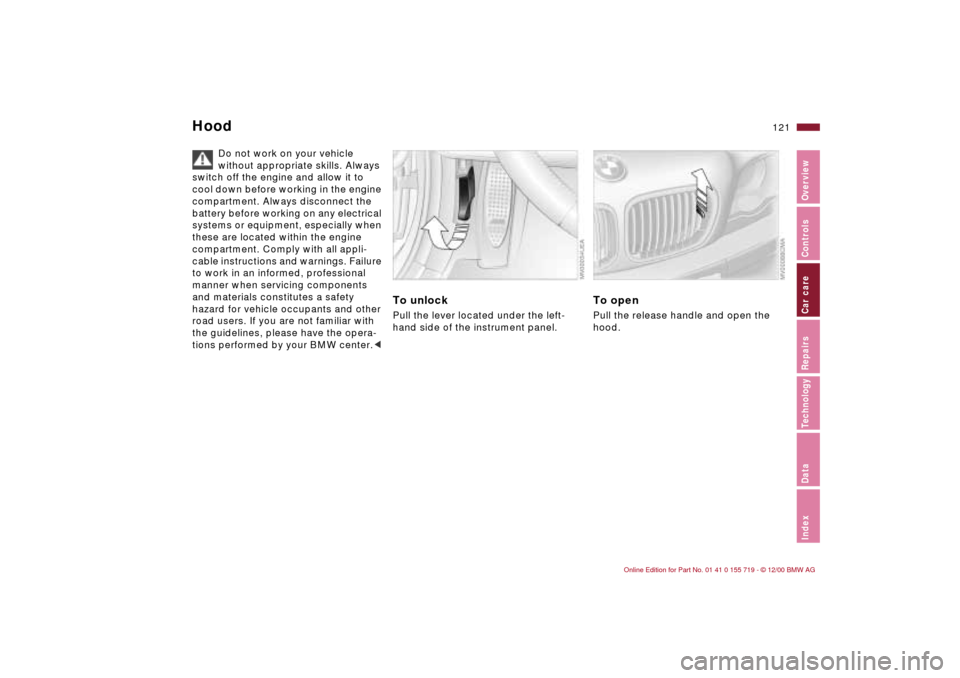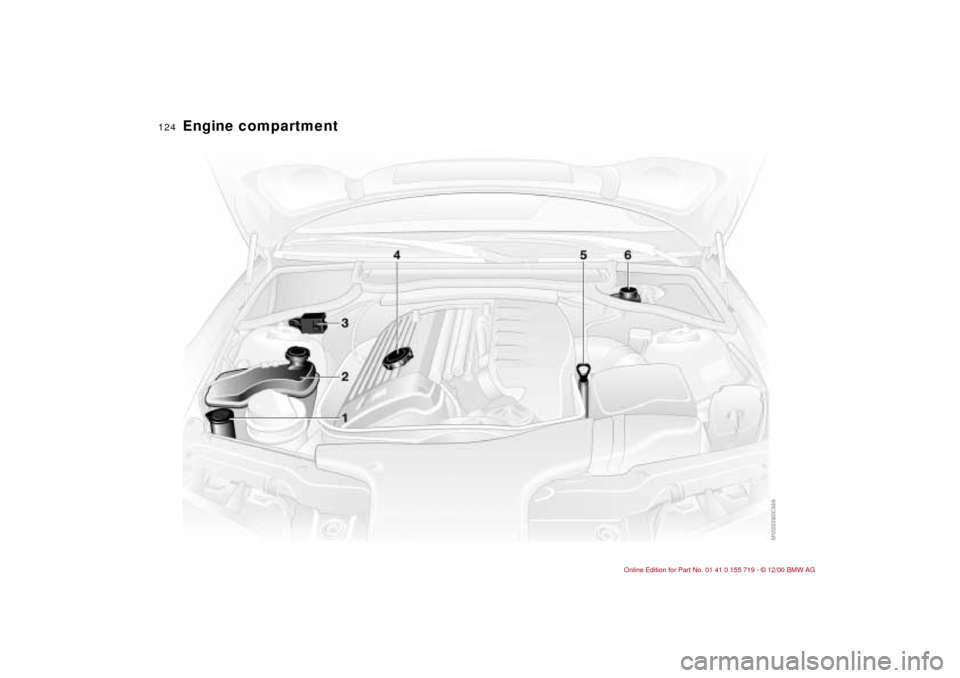2001 BMW M3 CONVERTIBLE engine
[x] Cancel search: enginePage 104 of 195

104n
To ensure that your vehicle continues to
provide maximum economy throughout
an extended service life, we request
that you devote careful attention to the
following section.
Your BMW M3 convertible is a
masterpiece of superlative tech-
nology. To create the basis for many
years of driving pleasure, we urge you
to observe the following precautions
during the initial operation period.<
Engine and differential>Up to 1,200 miles (2,000 km): drive at
varying engine and road speeds, but
do not exceed the following engine or
road speeds: 5,500 rpm or 105 mph
(170 km/h)
Do not depress the accelerator pedal to
the full throttle position.
>Following the Break-In Inspection at
1,200 miles (2,000 km), you can
gradually increase engine or road
speeds.
Follow the same break-in procedure if
either the engine or the differential is
replaced in the future.
TiresDue to technical factors associated
with their manufacture, tires do not
achieve their full traction potential until
after an initial break-in period. You
should therefore drive with extra care
during the initial 200 miles (300 km).
Obey your local and state maximum
speed limits.
When the vehicle is operated on
wet or slushy roads, a wedge of
water may form between the tire and
the road surface. This phenomenon is
referred to as aquaplaning, or hydro-
planing, and can lead to partial or
complete loss of traction, vehicle
control and braking effectiveness.
Reduce your speed on wet roads.<
Brake systemApproximately 300 miles ( 500 km) must
elapse before the brake pads and discs
achieve the optimal pad-surface and
wear patterns required for troublefree
operation and long service life later on.
To break-in the separate parking brake
drums, apply the parking brake lightly
when coasting to a standstill (at a traffic
signal, for instance), provided that
traffic conditions allow you to do so. To
avoid corrosion, repeat this procedure
from time to time.
The brake lamps do not come on
when the parking brake is
engaged.
Vacuum for the brake system servo unit
on your BMW is available only when the
engine is running. When you move the
vehicle with the engine off – when
towing, for example – substantially
higher levels of pedal force will be
required to brake the vehicle.
(500 km). Drive cautiously during this
break-in period and do not shift at high
engine speeds.
Break-in procedures
Page 105 of 195

105n
IndexDataTechnologyRepairsCar careControlsOverview
Brakes: do not rest your foot on
the brake pedal while driving.
Even light but consistent pressure on
the brake pedal can lead to high
temperatures, brake wear and possibly
even brake system failure.
Aquaplaning: when driving on wet or
slushy roads, reduce vehicle speed. If
you do not, a wedge of water may form
between the tires and the road surface.
This phenomenon is referred to as
aquaplaning, or hydroplaning, and can
lead to partial or complete loss of
contact between the tires and road
surface, vehicle control and braking
ability.
Driving through water: do not drive
through water on the road if it is deeper
than 1 foot (30 cm), and then only at
walking speed at the most. Otherwise,
the vehicle's engine, the electrical
systems and the transmission may be
damaged.<
The catalytic converter reduces harmful
pollutants in the exhaust emissions.
It is designed for use with unleaded fuel
only. Even minute quantities of lead
would be enough to permanently
damage both the catalytic converter
and the system's oxygen sensor.
To ensure efficient, trouble-free engine
operation and to avoid potential
damage:
>Be sure to comply with the required
scheduled maintenance work and
repair procedures.
>Fill the fuel tank well before it is
empty.
>Tow-start only when the engine is
cold, otherwise unburned, residual
fuel in the catalytic converter could
ignite and cause damage. It is better
to jump-start the vehicle with outside
assistance.
>Avoid other situations where the fuel
is not burned, or burns incompletely,
such as engaging the starter
frequently or for extended periods, or
repeated start attempts in which the
engine does not start (stopping and
restarting an engine which is running
properly does not present a problem).
Never let the engine run with any of
the spark plug cables disconnected. Be sure to observe the instruc-
tions above to prevent unburned
fuel from reaching the catalytic
converter. Otherwise there is danger of
overheating and damage to the cata-
lytic converter.
High temperatures occur in any vehicle
equipped with a catalytic converter.
Heat shields are installed adjacent to
some sections of the exhaust system.
Never remove these shields; do not
apply undercoating to their surfaces.
When driving, standing at idle, and
parking the vehicle, take extra care to
avoid contact between the exhaust
system and flammable materials (grass,
hay, leaves, etc.). Such contact could
start a fire, resulting in personal injury
and property damage.<
Driving notes Catalytic converter
Page 107 of 195

107n
IndexDataTechnologyRepairsCar careControlsOverview
Antilock Brake System (ABS)Antilock Brake System (ABS)/
Cornering Brake Control (CBC) CBC is an advanced engineering
feature of the ABS. When braking while
cornering at high speed or braking
during high lateral acceleration in
curves, or when braking during a lane
change, vehicle stability is improved
and steering response is enhanced.
In the event of a malfunction
If the ABS warning lamp comes
on, refer to page 21. The brake
system will continue to function
the same as on vehicles without ABS.
However, have the brake system
checked by your BMW center as soon
as possible. To prevent undetected
defects and cumulative faults from
adversely affecting the brake system,
refer any problems to your BMW center
at the earliest opportunity.
ABS warning lamp for Canadian
models.
If the brake warning lamp
comes on together with the indi-
cator lamps for ABS and DSC,
refer to page 21: then the entire
ABS, CBC and DSC
control
system has failed. Continue
driving cautiously and defen-
sively. Avoid full brake applica-
tions. This could cause the vehicle to
lose stability and you might no longer
be able to control it.
Have the system checked by your BMW
center as soon as possible.
CBC, ABS and DSC indicator
and warning lamps for Canadian
models.
Page 108 of 195

108n
Disc brakesDisc brakes furnish optimum decelera-
tion and braking control with greater
fade resistance under heavy use.
Using your vehicle only occasionally,
leaving your vehicle parked for
extended periods, and making only
minimal demands on your brakes
promotes brake disc corrosion and
brake pad contamination, because the
minimal loads required for your disc
brakes to self-clean have not been
reached.
If the brake discs are corroded, they will
tend to respond to braking with a
pulsating effect that even extended
brake applications will fail to cure.
For your own safety: use only
brake pads that BMW has
approved for your particular vehicle
model. BMW cannot evaluate non-
approved brake pads to determine if
they are suited for use, and therefore
cannot ensure the operating safety of
the vehicle if they are installed.<
Driving notes When driving in wet conditions and in
heavy rain, it is effective to apply light
pressure to the brakes every few miles.
Be aware of traffic conditions to ensure
that this maneuver does not endanger
other road users. The heat which is
generated by the brake applications
helps to dry the brake pads and discs.
Maximum braking force is obtained
while the wheels are not locked, but
rather when they are still barely turning
immediately prior to locking. ABS main-
tains this state automatically. If the ABS
should ever fail, pump the brakes if
possible (refer to page 111).
Drive down long or steep descents in
the mountains using a gear that
requires the least amount of braking.
Doing this prevents putting excessive
loads on the brakes, which in turn
keeps the brake system from possibly
being damaged. Stay within the allow-
able engine speed range. For further
information, refer to page 73.
Braking effect on the engine can be
further increased by downshifting, into
first gear, if necessary. Should the braking effect from the
engine prove inadequate, you should
still avoid extended, continuous
braking. Instead, decelerate the vehicle
by stepping hard on the brake pedal
(while watching out for drivers behind
you), and, if necessary, continue to
decelerate by pumping the brakes
(staggered braking). This staggered
braking technique allows the brakes to
cool in the intervals between active
braking phases. This prevents over-
heating and ensures that full braking
capacity remains available at all times.
Do not coast with the clutch
depressed, with the shift lever in
neutral or with the engine shut off. The
engine does not provide any braking
effect with the transmission in neutral or
with the engine shut off.
Do not allow floor mats, carpets or any
other objects to protrude into the area
around the brake pedal, the clutch or
the accelerator which could obstruct
their freedom of movement.<
Page 110 of 195

110n
Winter operationThe onset of winter is often accompa-
nied by rapid changes in weather.
Adaptations in driving style should be
accompanied by preparations on the
vehicle itself to ensure that your
progress through the winter remains
safe and trouble-free. CoolantBe sure that the coolant mixture
contains the year-round ratio of 50:50
water and extended-duty antifreeze/
corrosion inhibitor. This mixture
provides protection against freezing
down to approx. –34 7 (–37 6). Have
the coolant replaced every 3 years. LocksBMW door lock deicer can be used to
free them if frozen. This deicer also
contains lubricant.
After using the deicer, treatment with
BMW lock cylinder grease is recom-
mended.
Rubber components To prevent the weather-stripping from
freezing, apply a spray-on rubber treat-
ment or silicone spray to the door, hood
and luggage compartment lid seals.
A full range of car care products is
available from your BMW center.<
Snow chains Mount BMW snow chains
* only in pairs
on rear tires and always follow the
manufacturer's safety precautions. Do
not exceed a maximum speed of
30 mph (50 km/h) with snow chains. In
rare situations like these, it may be a
good idea to turn the DSC off briefly,
refer to page 80.
Deactivate the Tire Pressure Warning
system (RDW) when driving with snow
chains mounted. Snow chains can
cause the system to generate false
alarms and/or fail to detect pressure
loss, refer to page 81
Starting offWhen trying to drive out of deep snow,
or when "rocking" the vehicle to free it,
it may be prudent to temporarily deacti-
vate the DSC system. Refer to page 80. Driving on low-traction road
surfacesUse smooth, gentle pressure to control
the accelerator pedal. Avoid excessive
engine speeds and shift to the next
higher gear at an early point. Adapt
your speed and driving style when
approaching grades or slopes. Maintain
an adequate distance between yourself
and the vehicle ahead.
Page 121 of 195

121n
IndexDataTechnologyRepairsCar careControlsOverview
Do not work on your vehicle
without appropriate skills. Always
switch off the engine and allow it to
cool down before working in the engine
compartment. Always disconnect the
battery before working on any electrical
systems or equipment, especially when
these are located within the engine
compartment. Comply with all appli-
cable instructions and warnings. Failure
to work in an informed, professional
manner when servicing components
and materials constitutes a safety
hazard for vehicle occupants and other
road users. If you are not familiar with
the guidelines, please have the opera-
tions performed by your BMW center.<
To unlock Pull the lever located under the left-
hand side of the instrument panel.
To openPull the release handle and open the
hood.
Hood
Page 124 of 195

124n
Engine compartment
Page 125 of 195

125n
IndexDataTechnologyRepairsCar careControlsOverview
Engine compartment 1 Filler neck for headlamp and
wind-
shield washer system126
2 Coolant expansion tank129
3 Auxiliary terminal for jump-starting –
positive terminal164
4 Engine oil filler cap127
5 Engine oil dipstick127
6 Brake fluid reservoir130